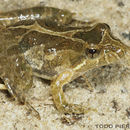Description
provided by AmphibiaWeb articles
Acris gryllus gryllus has a small body about 1.6-3.2cm long, a tapered snout, and anal warts. The head is pointed and has a dark triangle between the eyes (Behler 1979). A light bar extends from the eye to the forelimb. The thigh is marked by a clean, dark stripe surrounded by distinct light stripes. The other subspecies Acris gryllus dorsalis is similar in size and appearance to A. g. gryllus, except that it has no anal warts and the rear of its thigh is marked by two dark lines. Males have a grayish chest and throat with a round vocal sac. These body areas are usually more spotted in males than females (Stebbins 1954). Acris gryllus can be distinguished from other species of this genus by its longer hind legs and smaller degree of webbing on toes. Specifically, the webbing does not reach the tip of the first toe (Conant and Collins 1991).
Cochran, D. M. (1970). The New Field Book of Reptiles and Amphibians. G. P. Putnam's Sons, New York.
Distribution and Habitat
provided by AmphibiaWeb articles
A. g. gryllus ranges from southeastern Virginia to the Gulf Coast and the Mississippi River, while A. g. dorsalis ranges from southwestern Georgia to Alabama and the southern tip of Florida. Both are regularly terrestrial and lowland dwelling species, found in ponds, bogs, and river-bottoms. Occasionally found in upland regions such as northern river valleys. They favor grassy regions because vegetation offers protection (Conant and Collins 1991). Acris gryllus is not an able climber and therefore usually escapes danger by hopping around, leaping onto floating vegetation, or diving quickly to the bottom of a pond. It is a hardy frog and abundant wherever it is found (Cochran 1970).
Life History, Abundance, Activity, and Special Behaviors
provided by AmphibiaWeb articles
Acris gryllus is diurnal. It is especially active when startled. As a strong jumper, it can jump up to 2-3 feet high, covering a horizontal length of 3-4 feet. Diet consists of flying insects. Vocal call is a rapid succession of metallic "gick gick gick's" like a rattle. Calls begin at a duration of 1 second intervals but begin to accelerate to a maximum of about 6 calls per second. The clicking of two pebbles can induce Acris gryllus to call. A. g. gryllus breeds from February to October, depending on rainfall, while A. g. dorsalis can breed during any month. Breeding occurs in the water. Females lay eggs one by one and attach them to the rocks and the vegetation of pond bottoms. Eggs are dark brown or black with a tan colored bottom. Tadpoles develop to be 1/2 inch long after about 7-13 weeks. At this point, they are deep-bodied with a lower labium, indentations of a mouth, eyes, and an anus. They are distinguished by a distinct black tipped tail (Behler 1979).

